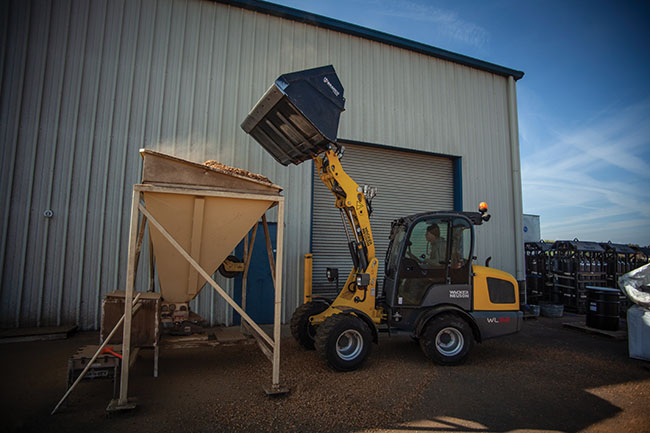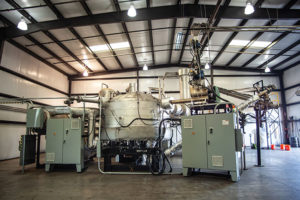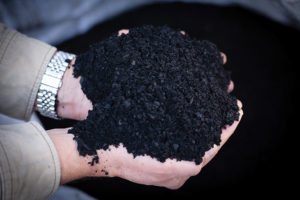
Jan/Feb 2022
The value in shell waste
California-based Corigin takes almond shells and sends them into a reactor that is the equivalent of a forest fire, producing products that are beneficial to farmers.
“This is our only ingredient,” said Mike Woelk, CEO of Corigin.
At this facility are 100 tons of almond shells waiting to be scooped, placed into a hopper and carried to the reactor. Though it looks calm from the outside, the inside of the reactor replicates a slow-burning forest fire – a cool forest fire that burns in the absence of oxygen, a process known as pyrolysis.
“The molecules are being liberated because the polymers are being broken up,” said Woelk. “If we starve that for air, we preserve those molecules, they don’t combust into CO2, and they convert to liquids.”
The vapors come off instantaneously when the shells hit, like the sizzle of tossing a raw steak into a hot pan. The system then constantly pulls those vapors out via vacuum for refining.
There are also four different condensing columns that are continuously scrubbing out the chemicals in that vapor stream. Temperatures and pressures are very carefully controlled with multiple heat exchangers in order to collect different liquids simultaneously. This becomes Coriphol – a plant growth enhancer for use in conventional and organic fields.
“It’s very difficult to refine these vapors continuously. One could collect all of the vapors as a single condensate relatively easily, but then it would become a soupy, tarry mess,” said Woelk.
As the shells move through the system, any trapped air is displaced with nitrogen. The shells are then dropped into the reactor, which is heated inside to 475˚ C – over 880˚ F – where they’re stirred and charred. The biochar then makes its way through three different conveyors before being collected into large white sacks.

The reactor
The reactor is incredibly well-insulated and is heated by melting salt, essentially turning it to lava. That hot salt is then piped into the system where it circulates beneath a hollow plate, onto which the shells are dropped. Salt is the best option because it doesn’t involve a direct flame.
“It’s very difficult to control the temperature of a flame,” Woelk said, “but it’s very easy to control the temperature of a liquid once it’s produced.”
Salt also sets a different safety standard. Since there is no direct flame, a runaway pressure build up on the system is unlikely. A leak would result in salt on the floor. Since the system is under negative pressure, it will suck air in, not push anything out.
“The salt cools down really quickly, too, so it’s an incredibly safe system,” Woelk said.
On one ton of biomass, the system generates 80% product yield, breaking down to 30% biochar, 30% Coriphol, 30% bio-oil, and the remaining percentage as gases that can no longer be condensed into liquid. Those gases are then burned off to produce heat, which then heats the salt.
It’s a closed loop system, and the burning is happening in an extremely clean way, particularly in a time when air resources boards are phasing out agricultural burning. It also creates valuable products that growers can then use in their fields.
Costs down, marketable yield up
Corigin is still fresh off the heels of a 900-acre tomato trial that was compared against a neighboring 2,400 acres using a popular competing product.
“The farmer was nervous. He said he had a semi truck full of fertilizer ready to go the second we saw anything wrong with this,” recalled Woelk. “And then he gave us the go-ahead.”
That grower saw a 34% increase in marketable tonnage on those 900 acres. That field also used half its normal fertilizer requirements. The increase in revenue – from the boost in net profit to the reduction in input costs – is why Woelk is on a mission to change the perception of “regenerative” and show growers some tools that will make it worth their while.
“This is where fire ecology meets chemical engineering to solve the regenerative ag challenge,” Woelk said.

The regenerative dilemma
Defining what “regenerative” means in agriculture is key to its adoption.
“Regenerative agriculture still seems to be a euphemism for small-scale, ‘hippy stuff’ that’s really expensive and doesn’t work,” said Woelk. “But we’re saying it’s actually cheap and works really well. We’ll help you increase your farm income per farmed acre simply by doing what everyone in the world wants growers to do – use less fertilizer, use less chemicals, and think about regenerative practices.”
The answer, it seems, has been in front of people all along – the biochemistry in agricultural waste. Taking the plant’s natural chemistry, which is collected with heat instead of enzymes, and putting it onto the plants in advance is helping them to grow faster, better and have higher marketable yields.
“Plants are solar-powered biochemical factories, but we don’t generally think of them that way,” said Woelk.
Biochar, carbon removal credits and sequestration
Where the original almond shells may decompose in a few years in the soil, the biochar does not. Biochar is also carbon negative, making one ton of Corigin’s biochar the equivalent of three tons of carbon dioxide pulled from the atmosphere.
There’s also the added bonus of carbon removal credits.
“Carbon removal credits are very valuable because there’s just not enough supply for all the demand out there. Everybody has made these bold commitments, and now nobody knows how they’re going to do it,” said Woelk. “It’s going to be tough, and it will drive the price up.”
Adding a bit every year to a field builds the carbon stock in the soil – the carbon returns to the field and doesn’t come back out. It also holds five times its weight in water, and is so porous that it retains moisture, nutrients and microbes that thrive in that structure. Biochar helps improve soil structure and the microbiome, which then sequesters even more soil carbon and further improves fertility.
Popular perception is that planting more trees can fix the carbon crisis, but Woelk disagrees with this idea for true sequestration, and stresses that the best answer is not in living plant matter, but in dead plant matter that decomposes
or mineralizes at a much slower rate. Biochar and focusing on the topsoil is Corigin’s answer.
“Putting carbon deep underground or in the atmosphere creates no additional value. Putting carbon into the oceans acidifies them. There isn’t enough carbon in plants to satisfy this, which leaves us with topsoil, where high carbon levels mean high soil fertility,” said Woelk. “Then we fundamentally shift the origin of carbon from fossil fuels to the atmosphere. That’s a game changer.”
Immediate plans are to build three more processing systems that are four times bigger than the location in Merced, as well as utilize other agricultural waste, such as from walnuts, pistachios, rice, citrus and forestry.
Above: Almond shells are dumped into a hopper, carried into the facility and dropped into the reactor. Photo: Matt Hannon







